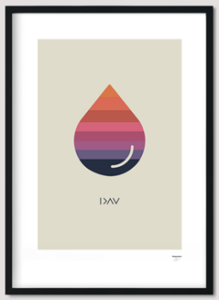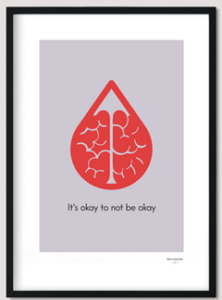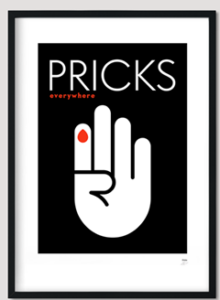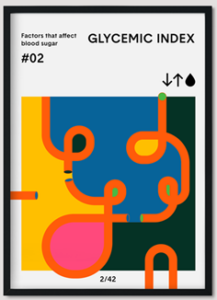Location, location, location. Does cannula site affect AID performance? by Tim Street for Diabettech.com, 7 November 2024.
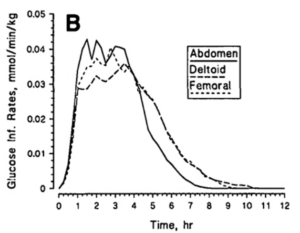 Rotate your injection or infusion sites. That’s a key message that anyone living with type 1 is delivered very early in their life with the condition. And for good reason. Nobody wants to have to live with scar tissue or lipohypertrophy affecting their insulin absorption.
Rotate your injection or infusion sites. That’s a key message that anyone living with type 1 is delivered very early in their life with the condition. And for good reason. Nobody wants to have to live with scar tissue or lipohypertrophy affecting their insulin absorption.
But within the advice about location lies another reality, before we get to any tissue damage. Different locations on the body absorb insulin at different rates. The variation can be quite substantial. Variations due to the site you use might affect the time insulin takes to hit maximum concentration and the maximum concentration, which would affect the “power” of it to reduce glucose levels.
Read more: Location, location, location. Does cannula site affect AID performance?
Awakening to the Dawn Phenomenon in Diabetes by Batya Swift Yasgur for Medscape.com, 7 November 2024.
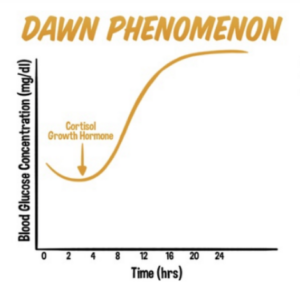 The “dawn phenomenon” (DP) describes a pattern in which episodes of hyperglycemia are experienced by patients with diabetes or prediabetes during the early morning hours (usually between 3:00 and 8:00 AM). It typically occurs in the absence of prior nocturnal hypoglycemia. The term was first coined by Schmidt and colleagues in 1981 to refer to a rise in morning fasting glucose in patients with type 1 diabetes (T1D). The DP is quite common, affecting 54% of individuals with T1D, 55% of individuals with T2D, and approximately 30% of individuals with prediabetes or insulin resistance. Research suggests that patients with diabetes with the DP have poorer outcomes and higher rates of all-cause mortality than those without the DP.
The “dawn phenomenon” (DP) describes a pattern in which episodes of hyperglycemia are experienced by patients with diabetes or prediabetes during the early morning hours (usually between 3:00 and 8:00 AM). It typically occurs in the absence of prior nocturnal hypoglycemia. The term was first coined by Schmidt and colleagues in 1981 to refer to a rise in morning fasting glucose in patients with type 1 diabetes (T1D). The DP is quite common, affecting 54% of individuals with T1D, 55% of individuals with T2D, and approximately 30% of individuals with prediabetes or insulin resistance. Research suggests that patients with diabetes with the DP have poorer outcomes and higher rates of all-cause mortality than those without the DP.
“The dawn phenomenon is likely due to a number of hormones that rise close to the morning hours,” said Marc-Andre Cornier, MD, professor of medicine, and James A. Keating, Endowed Chair in Diabetes, Medical University of South Carolina, Charleston, South Carolina. Throughout the day, hepatic glucose metabolism fluctuates, with an increase in glycogenolysis and gluconeogenesis during the early morning hours. In people without diabetes, plasma insulin tends to remain stable and consistent during the night, with a slight, transient increase in insulin secretion just before dawn. This increase in insulin suppresses hepatic glucose production, thereby preventing hyperglycemia. But in the absence of sufficient insulin, this transient increase in hepatic glucose production can lead to hyperglycemia.
Additionally, cortisol and growth hormone rise during the night, especially toward the morning, explained Cornier, who is also the director of the Division of Endocrinology, Diabetes and Metabolic Diseases, Department of Medicine, Medical University of South Carolina, Charleston, South Carolina. “This is normal and happens in everyone, and for most people, the body takes care of it.”
Read more: Awakening to the Dawn Phenomenon in Diabetes
What is the Hidden Disabilities Sunflower? by HDSunflower.com … is a simple tool for you to share that you have a hidden disability voluntarily. Simply by wearing the Sunflower, you’re just letting everyone know that you might need extra help, understanding, or just more time.
 Since its launch in 2016, businesses from every sector have been joining the global Sunflower network – ranging from retail, travel and tourism, transport including over 200 airports – as well as railway networks, coach and bus services and ferries, education (universities, schools and colleges), healthcare, central and local government agencies to football teams, theme parks, theatres and financial institutions. The Sunflower has launched locally in Australia, Belgium, Brazil, Canada, Denmark, Ireland, Latin America, the Netherlands, New Zealand, the UK, the UAE and the USA.
Since its launch in 2016, businesses from every sector have been joining the global Sunflower network – ranging from retail, travel and tourism, transport including over 200 airports – as well as railway networks, coach and bus services and ferries, education (universities, schools and colleges), healthcare, central and local government agencies to football teams, theme parks, theatres and financial institutions. The Sunflower has launched locally in Australia, Belgium, Brazil, Canada, Denmark, Ireland, Latin America, the Netherlands, New Zealand, the UK, the UAE and the USA.
Without a visual cue, it can be difficult for others to identify, acknowledge, or understand the daily barriers faced by people living with an invisible disability. We searched for a discreet sign that is clearly visible from a distance as well as being distinctive, joyful, and dynamic. We chose a sunflower as it suggests happiness, positivity, strength as well as growth and confidence and is universally known.
Occasionally when out and about, you may see multiple people wearing a sunflower lanyard. In some instances, it may seem like these people are receiving special treatment, like being moved quicker through long lines — but there’s actually a very good reason for this. Here’s what it means when someone is wearing a sunflower lanyard.
 What does a sunflower lanyard mean? People with hidden disabilities will often wear sunflower lanyards to indicate to the stadium staff of their status. There are a lot of different disabilities and chronic illnesses that could be negatively affected by the stress that comes with attending a concert at a big stadium. Because of this, wearing something with a sunflower, like a lanyard, indicates to the staff that the person may need additional assistance during the concert.
What does a sunflower lanyard mean? People with hidden disabilities will often wear sunflower lanyards to indicate to the stadium staff of their status. There are a lot of different disabilities and chronic illnesses that could be negatively affected by the stress that comes with attending a concert at a big stadium. Because of this, wearing something with a sunflower, like a lanyard, indicates to the staff that the person may need additional assistance during the concert.
Many businesses have been trained to recognize this symbol, encouraging their employees to be on the lookout for people wearing a sunflower lanyard (or some other subtle sunflower visual). When spotted, trained staff members will know to offer extra assistance to those attendees, whether that be aiding them in moving through long lines quicker or making sure they have appropriate accommodations.
-
-
- Read more: About the Hidden Disabilities Sunflower
- How to Order: SHOP Hidden Disabilities Sunflower Products
-
Insulin resistance caused by sympathetic nervous system over-activation by Justin Jackson for MedicalXpress.com, 2 November 2024.
 Rutgers Robert Wood Johnson Medical School and collaborating institutions have found that overnutrition leads to insulin resistance and metabolic disorders through increased activity of the sympathetic nervous system (SNS). The study shows that reducing SNS activity can prevent insulin resistance induced by a high-fat diet, suggesting a new understanding of how obesity causes insulin resistance.
Rutgers Robert Wood Johnson Medical School and collaborating institutions have found that overnutrition leads to insulin resistance and metabolic disorders through increased activity of the sympathetic nervous system (SNS). The study shows that reducing SNS activity can prevent insulin resistance induced by a high-fat diet, suggesting a new understanding of how obesity causes insulin resistance.
Obesity causes type 2 diabetes and metabolic diseases primarily by inducing insulin resistance. Impaired cellular insulin signaling is the most understood mechanism, but it does not always accompany impaired insulin action, indicating other factors must be involved. Overnutrition has been known to rapidly increase plasma norepinephrine (NE) levels, indicating overactivation of the SNS. Methods that directly measure SNS activity, such as nerve recordings and NE turnover, often report increased SNS activity in obesity.
In contrast, studies focusing on adrenergic signaling pathways sometimes report reduced catecholamine responses, interpreted as decreased SNS activity. This discrepancy may be explained by the development of catecholamine resistance due to chronic sympathetic overactivation, leading to diminished physiological responses despite elevated NE levels.
Read more: Insulin resistance caused by sympathetic nervous system over-activation
U.S. Diabetes Rates Rise to Nearly 1 in 6 Adults by Ernie Mundell for HealthDay.com, 6 November 2024.
 Nearly 16% of American adults — that’s close to 1 in 6 — now has diabetes, according to the latest data from the U.S. Centers for Disease Control and Prevention. Increasing age and widening waistlines greatly increase the odds for the disease, which happens when the body doesn’t use insulin properly, resulting in high blood sugar levels. The new data, collected from mid-2021 through mid-2023, found a big rise in diabetes rates since 1999-2000, when 9.7% of adult Americans had the disease.
Nearly 16% of American adults — that’s close to 1 in 6 — now has diabetes, according to the latest data from the U.S. Centers for Disease Control and Prevention. Increasing age and widening waistlines greatly increase the odds for the disease, which happens when the body doesn’t use insulin properly, resulting in high blood sugar levels. The new data, collected from mid-2021 through mid-2023, found a big rise in diabetes rates since 1999-2000, when 9.7% of adult Americans had the disease.
Read more: U.S. Diabetes Rates Rise to Nearly 1 in 6 Adults
NEW PRODUCT!!! Companion Cards by Diabetes By Design, designed by Alex Durusel-Baker, a designer living in Edinburgh, Scotland.
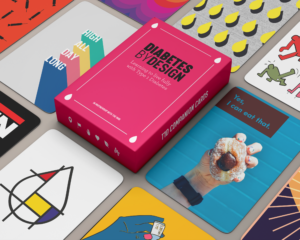 Diagnosed with Type 1 diabetes at 30 and struggling to cope with the mental strain of a widely misunderstood disease, she created dozens of diabetes-inspired posters to entice people into learning about Type 1 diabetes. The project helped her make sense of her newfound condition and rebuild bridges with family and friends that she had been shutting out.
Diagnosed with Type 1 diabetes at 30 and struggling to cope with the mental strain of a widely misunderstood disease, she created dozens of diabetes-inspired posters to entice people into learning about Type 1 diabetes. The project helped her make sense of her newfound condition and rebuild bridges with family and friends that she had been shutting out.
In 2019, the posters culminated in an exhibition that caught the eye of the professional healthcare community. Excited by her novel approach to building awareness of the condition, Alex was invited to present her work at the Diabetes UK Professional Conference. She now collaborates with diabetes medical specialists to develop new ways to support people living with type 1 diabetes and redefine what it means to live and thrive with a chronic condition. Alex writes and creates the artwork for the Companion Cards.
I had to opportunity to interact with these cards, pre-launch, at the DiabetesMine D-Data Innovation Summit in San Diego, CA, 7 November 2024. I was SO impressed at the creative impact of these cards, designed to
-
-
- Explore, learn & reflect about living with T1D
- Share, educate & spark conversation with friends & family
- Build rapport & get targeted support from your healthcare providers
-
The Companion Cards Toolkit is made up of 62 cards grouped into 6 sets that explore the multiple facets of living with type 1 diabetes. are in development and will be available later this year, join our mailing list to be the first to know when they are ready.My experience was in a T1D conference setting with many tables of 6-8 people. Everyone chose a card … and then shared what that card’s message meant to them, in their lives and experiences with diabetes. Everyone was engaged and excited to share their reactions and feelings. Some suggestions about how these can be used?
-
-
- In any support group settings, to encourage discussion of feelings about T1D
- as artwork in your doctor’s office
- in any discussion between parent and child
- indeed anywhere that you can talk freely and expressively about your feelings and experiences living with diabetes. I LOVE these cards … even as a once/day check-in on how you or your friends/family feel about your disease.
-
A SUGGESTION: If you might be interested in participating in a Zoom call to try out these cards in a group setting, let me know: joanne@thesavvydiabetic.com
Read more: Companion Cards by Diabetes By Design
